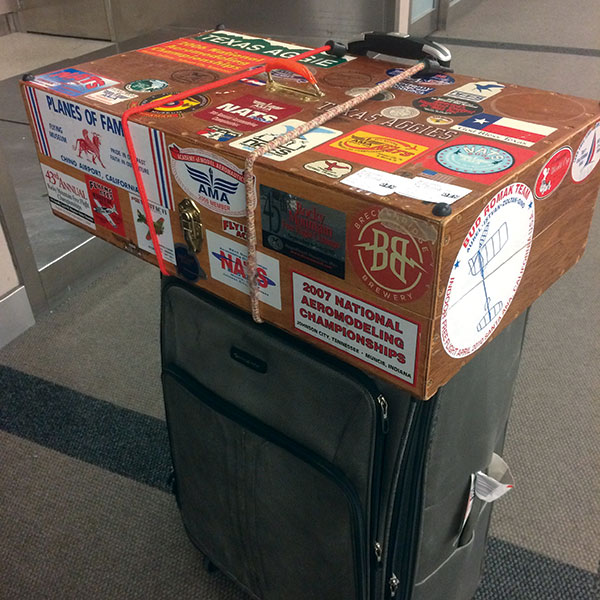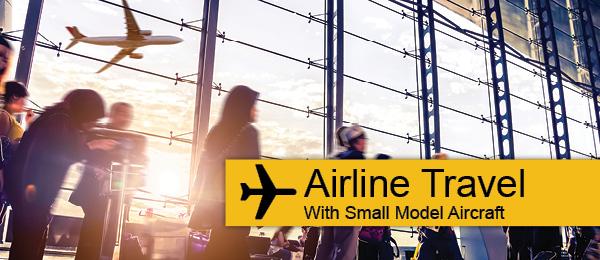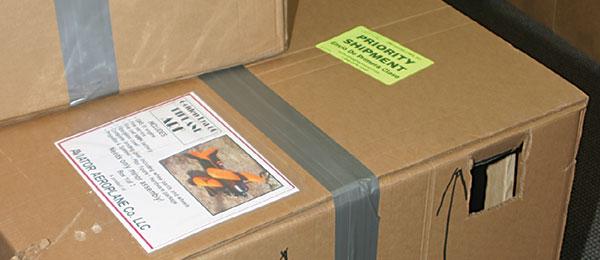Written by Don DeLoach
Photos by Lee Hines and the author
Tips to ensure that your models arrive safely
As seen in the June 2018 issue of Model Aviation.
Having traveled to Free Flight (FF) meets on commercial airline flights for nearly three decades, I’ve learned a lot about how to do it right. Driving to a meet is still my preference because of the freedom you’re afforded in packing, but flying to meets should not be considered prohibitively difficult either. With some basic box-building skills and the application of common (and not-so-common) sense, you too can join the ranks of the modeling jet set.
Not Bringing Your Models Aboard
The best plan, if you can do it, is to get friends who might be driving to the same meet to haul your model boxes for you while you hop a flight. Chip in for gas or buy them dinner. The peace of mind that comes from fellow modelers handling your aircraft instead of non-modeling strangers is priceless. This is always my preference. If you are forced to take models onto a commercial flight, you can do it safely. I’ve done so on roughly 200 flights throughout the decades, with almost no damage. I transport extremely fragile, stick-and-tissue FF models that weigh .5 to 3 ounces, and there has been no model damage during most of those years. I fly commercially to four or five meets a year, which usually amounts to 8 to 12 flight segments. The times I did incur damage, it was extremely minor, and was usually the result of improper packing—my fault, not that of the airline.
The author’s gear is at the airport ready to travel to another FF event.
Know Your Limits
The first thing to understand is the checked-baggage rules for major domestic airlines. Nearly all of them allow up to 62 total linear inches, which includes the sum of length, width, and height. The weight limit is also a consideration—50 pounds, although support equipment usually outweighs lightweight model boxes. I’ll get to support equipment later. I have two large model boxes that I check on contest trips. Both are slightly (1 to 4 inches) larger than the 62-inch limit. In the 200 or so flight segments I’ve been on, only three times has a ticketing agent actually measured my boxes. Once, the person ignored the fact that the box was a couple inches over the limit; another time I was charged $200 for oversize baggage by United Airlines; and the third time Southwest Airlines charged me $75. Obviously, the safest approach is to make the boxes at or under the limit, but because I’ve been charged on fewer than 2% of my trips, I consider the risk acceptable. What I’ve found throughout the years is that airlines are much tighter on restricting baggage weight than they are on restricting length, width, and height. This brings up an important point—the importance of being nice to the ticketing agent. When you walk up with an odd-looking homemade wooden model box, you must realize that you will be looked at differently than other passengers. Most of the baggage agents will ask what is in the boxes. Tell them the truth, and be prepared for them to request a signature absolving the airline of liability. The first time I was asked to do this I politely pushed back a little. Since then, though, and after many years of experiencing no damage, I sign and continue with my trip, knowing from experience how rare damage is.Carrying On
One of the smartest things you can do is to pack as many models as possible into a small carry-on box. This way your models are never out of your control. My carry-on box for Flying Aces Club (FAC) Scale models is 25 x 14 x 7 inches. At 461/2 inches total, it is 11/2 inches over the carry-on limit of 45 inches. My longer box for AMA and FAI FF models is 30 x 10 x 51/2 inches, which is only 1/2 inch above the limit. I’ve never had either carry-on measured at the gate, although one time a particularly grumpy gate agent announced that my box would have to be gate checked because the overhead bins were full. I calmly explained that the box contained handmade models. I then I opened it to show the contents, and he relented. Occasionally, I have had to cram my box under the seat in front of me, but anything is better than having it gate checked. A related point: You have to do everything you can to ensure that you don’t check in late for your flight. If you are late, you’ll often board the aircraft when the overhead bins are nearly full, leaving little room for your model box and increasing the necessity that your carry-on will be gate checked. You can’t gate check a carry-on model box, so plan ahead. I set an alarm to check in exactly 24 hours before my departure time.Model Box Construction
I have two main “suitcase” boxes that I check on domestic flights. They are 30 x 22 x 11 inches and 38 x 15 x 11 inches. Both are made of 3/4-inch square pine blocking at the corners, and skinned with either 1/8-inch lauan plywood or 3/8-inch aspen or birch plywood.
The author’s smaller carry-on box is next to his suitcase-size box. In the carry-on, fuselages are rubber-banded to the lid and the remaining parts are loosely packed on the bottom.
The 3/8-inch plywood box is much stronger, yet is still far less than the maximum 50-pound weight. All of my future suitcase boxes will be made of 3/8-inch wood. The 1/8-inch lauan is cheaper material that is generally used for door skins. It is good for smaller model boxes and carry-ons, but is slightly fragile for larger suitcase boxes. The one upside is that lauan is low in weight. All of my boxes are glued with Titebond II and fastened with 1/2-inch #6 wood screws or small 1/2-inch brads shot from a staple gun. The latter is easier and quicker, but the former is stronger. Attach quality piano hinges, draw catches, and a sturdy handle to each. Finally—and this is important—I emblazon each checked box with the words “Delicate Instruments.” Another part of the box says “Do Not Drop,” and perhaps I’ll include a “Fragile” or two, although that word is so overused it is nearly meaningless to baggage handlers. Some of my boxes are lightly stained and all are well sealed with three or four coats of polyurethane. The polyurethane is necessary because sometimes luggage is loaded and unloaded during downpours.
Model Boxes as Suitcases
I believe that the two keys to carefully handling your model box are making it look conspicuous (e.g. varnished wood, not a nondescript painted box that blends in with other, more-rugged luggage) and the words “Delicate Instruments.” The words are carefully considered. I want the baggage handlers to fear the consequences of damaging my boxes. Delicate instruments implies extreme importance. Perhaps the box contains a $10,000 telescope, and if that’s what the handlers imagine, perfect. If I put “Model Aircraft” on the side, I trivialize the contents. Handlers would likely think “toys, inexpensive, and unimportant,” and your box gets tossed and dropped like every other suitcase. As a final consideration with checked model boxes, you must anticipate that the metal clasps and catches will be destroyed during the loading/unloading process, although they usually make it through okay. Once I had both catches completely torn off. The models inside were undamaged, but how did the lid stay closed? The answer: a sturdy 1-inch nylon lashing strap (item #67386) from Harbor Freight. Don’t ever forget your safety strap.Packing Your Models
There are two general approaches to packing your checked boxes. You can strap down wings, fuselages, and other parts, or you can loosely pack them then fill the voids with crumpled tissue paper or plastic grocery bags. Both approaches work well; just prepare for the fact that TSA agents will usually open your boxes to visually inspect the contents. You want to make sure that they aren’t going to damage anything during that process. Don’t pack anything too close to the edges. Remember, these people see hundreds of suitcases a day; make it easy for them to not accidentally break something.
In the author’s 30 x 22 x 11-inch suitcase box for FAC models, everything is strapped down with rubber bands to the lids, sides, and floor of the box. Don can fit as many as nine models into this box.

Here is Don’s 38-inch checked box, full of models, just before stuffing the voids with crumpled tissue paper. Fuselages are again strapped to the lid. Photo by Lee Hines.
Support Equipment
I pack my support equipment (winding stooge, rubber motors, winders, hammer, binoculars, stakes, and other heavy gear) in a large roller suitcase. I put my clothing and toiletries in the same suitcase, using it as padding for heavier and odd-shaped items such as winders and hammers. Remember well that the airlines rigidly enforce the 50-pound weight limit. For a while I used an empty 12- to 15-pound suitcase and I often exceeded the 50-pound limit when traveling to attend a long contest. This sparked a search for a lightweight, full-size suitcase. I found several options. The lightest I found was the Los Angeles roller bag by It Luggage. It is maximum sized at 321/2 x 20 x 11 inches, yet weighs a scant 5.4 pounds. Best of all, it was inexpensive at approximately $70 on sale from eBags.com.
The Los Angeles roller bag by It Luggage along with typical support equipment.
Shipping Your Models
One final option is shipping your models. This is a well-proven method as well, but you need the right box. I strongly recommend 275-pound, double-wall cardboard, such as the boxes sold by Uline.com. Check out the 36 x 12 x 12-inch box (#S-11258). Pack the models on a bed of grocery bags and fill the voids with the same. I’ve packed as many as 12 models in this size of box and recently shipped it to Muncie, Indiana, from Colorado for a mere $16 via the U.S. Postal Service.—Don DeLoach [email protected]










Comments
Air travel
Sorry but I won't be traveling by air at all. No more. I will not put up with being violated and treated like some criminal by some overpaid useless government workers/welfare program for low IQ ex prison inmates.
Unless you want your valuables stolen along with your dignity and humanity, then don't fly at least on a commercial airline.
The TSA is a costly government welfare program that has failed on every level.
There is no good reason for the TSA to continue to exist except to harass travelers and collect a paycheck.
Feedback
Ok. It is time we met. I think I have seen you on flights out of COS over the years. I am a lifelong ff modeler. Some of my models have made Flying Models, and Dave Diels uses my photos in his advertising. As my house filled with models, I switched to card paper models. I still built a couple of stick and tissue each year. After about 300 of those, my wife had enough. Coincidentally, I acquired carpal tunnel injury. I have lost sensation and fine motor skills in my hands. I have not tried to build anything lately. So, how can I become active in FAC, etc? BTW, I am almost eighty years old.
Air Travel
Sorry but I won't be traveling by air at all anymore. I will not surrender my rights, my dignity and my self to a bunch of overpaid welfare loafers wearing badges and a gun known as the TSA.
The American people have been stripped of their dignity and humanity by these illiterate idiots. The TSA has accomplished one thing and that is to harass travelers and steal their valuables. The TSA has cost the Americans people hundreds of billions in another government waste program that has amounted to absolutely nothing.
There is nothing positive about traveling by air . There is nothing positive about the TSA it is a total waste of taxpayers money while at the same time stripping travelers of their dignity and humanity.
If I had my way the TSA would be shut down immediately. They would all be sent out on the highways to pick up trash which is what they're really good for.
Add new comment